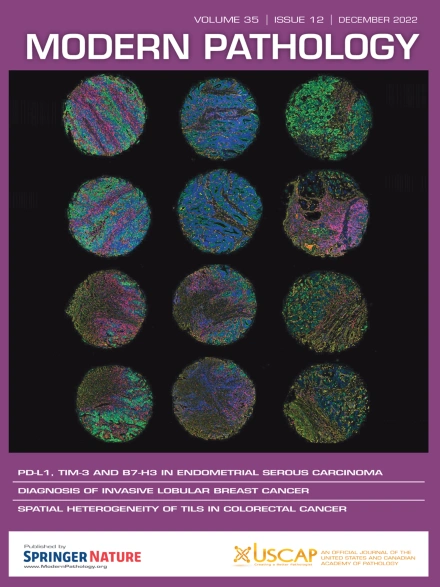Differential Localization of β-Catenin Protein in CTNNB1 Mutant Endometrial Cancers Results in Distinct Transcriptional Profiles
IF 5.5
1区 医学
Q1 PATHOLOGY
引用次数: 0
Abstract
CTNNB1 exon 3 mutation is a well-established driver of nearly 30% of endometrioid endometrial cancers (EECs), and this is associated with worse patient survival. Paradoxically, we have previously demonstrated that mutant β-catenin protein does not robustly localize to the nucleus in these cancers. The purpose of this study was to determine downstream gene expression in these cancers with nuclear or membrane/cytoplasmic mutant β-catenin protein localization. Spatial transcriptomics was performed on tumors with intratumor nuclear and nonnuclear mutant β-catenin, using the protein localization to select for regions of interest (ROIs). Differential expression analysis of all nuclear and nonnuclear ROIs yielded distinct transcriptional profiles based on the localization of β-catenin. Analysis revealed enrichment for Wnt signaling and epithelial-to-mesenchymal transition pathways in nuclear ROIs and hormone signaling in nonnuclear ROIs. Hierarchical clustering yielded 2 clusters comprised of almost entirely nuclear or nonnuclear ROIs. A novel therapeutic target, TROP2, encoded by the TACSTD2 gene, was identified to be altered by Wnt/β-catenin signaling. These data provide evidence for highly heterogeneous intratumor transcriptional profiles dependent on β-catenin protein localization in EEC with CTNNB1 driver mutations. Therefore, reporting of β-catenin immunohistochemistry should include an estimated percentage of tumor with nuclear localization in EEC tumors with exon 3 CTNNB1 mutations.
β-catenin蛋白在CTNNB1突变子宫内膜癌中的差异定位导致不同的转录谱。
CTNNB1外显子3突变是近30%的子宫内膜样子宫内膜癌(EEC)的一个公认的驱动因素,这与较差的患者生存有关。矛盾的是,我们之前已经证明突变β-连环蛋白在这些癌症中并不能稳定地定位于细胞核。本研究的目的是确定这些核或膜/细胞质突变β-连环蛋白定位的癌症中下游基因的表达。空间转录组学对肿瘤内核和非核突变β-catenin进行研究,利用蛋白质定位选择感兴趣区域(ROI)。基于β-catenin的定位,所有核和非核roi的差异表达分析得出了不同的转录谱。分析显示,核roi中wnt信号通路和上皮-间质转化通路富集,非核roi中激素信号通路富集。分层聚类产生了几乎完全由核或非核roi组成的两个集群。一个新的治疗靶点,TROP2,由TACSTD2基因编码,被发现被Wnt/β-catenin信号改变。这些数据为CTNNB1驱动突变的EEC中依赖于β-catenin蛋白定位的高度异质性肿瘤内转录谱提供了证据。因此,β-catenin免疫组化的报告应该包括估计百分比的外显子3 CTNNB1突变的EEC肿瘤的核定位。
本文章由计算机程序翻译,如有差异,请以英文原文为准。
求助全文
约1分钟内获得全文
求助全文
来源期刊

Modern Pathology
医学-病理学
CiteScore
14.30
自引率
2.70%
发文量
174
审稿时长
18 days
期刊介绍:
Modern Pathology, an international journal under the ownership of The United States & Canadian Academy of Pathology (USCAP), serves as an authoritative platform for publishing top-tier clinical and translational research studies in pathology.
Original manuscripts are the primary focus of Modern Pathology, complemented by impactful editorials, reviews, and practice guidelines covering all facets of precision diagnostics in human pathology. The journal's scope includes advancements in molecular diagnostics and genomic classifications of diseases, breakthroughs in immune-oncology, computational science, applied bioinformatics, and digital pathology.
 求助内容:
求助内容: 应助结果提醒方式:
应助结果提醒方式:


